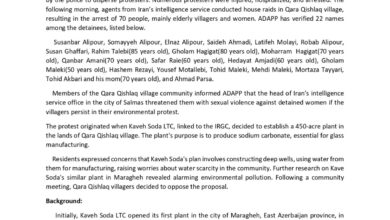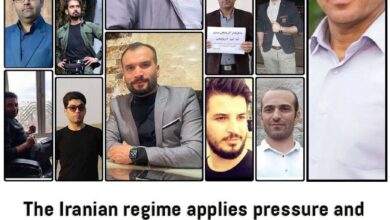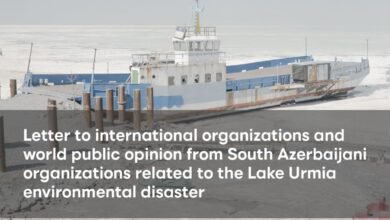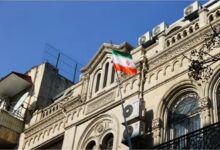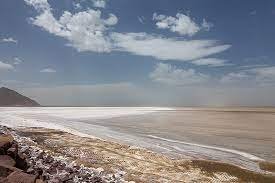
Urmia lake is the largest saltwater lake in the Middle East and the sixth largest globally, the lake has dramatically shrunk in recent years. This environmental disaster has serious ecological, social, and political ramifications, notably on the Azerbaijani Turk population residing around the lake. This intricate interplay of environmental degradation and ethnic tensions could escalate into a broader crisis if not addressed comprehensively and equitably.
Lake Urmia has played an integral role in the Azerbaijani people’s lives, culture, and livelihoods for centuries. As the lake’s condition worsens, this community, long living in harmony with their treasured resource, has found its voice growing louder in protest.
Climate Change and Environment
Climate change is among the most complex challenges that humans are faced with currently and in the future. Since the early 1980s, the remarkable warming of the Earth due to the rise of CO2 and other greenhouse gases caused by human activities has been the main factor of climate change in the recent century. Lake Urmia has witnessed severe area reduction in recent decades. The shrinking process in the lake began in the mid-2000s and is now exposed to the danger of full drying.
The drying of the lake has been attributed to several reasons, including drought, construction of a highway on the lake, increasing use of water resources of the lake basin, and low precipitation and snowfall. Until 2012, more than 200 dams on river basins of the lake were ready for operation or in the last design stages. In October 2015, the water level of Lake Urmia was announced to be 1,270.04 m, showing a reduction by 40 cm compared to that of October 20141. As a consequences, the regional temperate weather will change into hot weather along with salt storms, changing the regional environment. In addition to salt, many contaminations containing toxic heavy metals used in the industry and agricultural pesticides have penetrated the surface and subsurface water resources related to the lake. In the case of drying of the lake, most poisonous materials will become airborne, posing the risks of respiratory diseases for people and threatening the ecosystem of the region. In 2014, a national workgroup, entitled Lake Urmia Survival, began to address the crisis and performed measures whose positive effects emerged in the past 2 years. On August 14, 2020, however, the lake level was announced to be 1,271.41 m above mean sea level, with an equivalent area and a volume of 2,900 km2 and 3.75 billion m3, respectively. Compared with the beginning of the Lake Urmia survival plan on August 14, 2014, it has risen by 126 cm, equivalent to 1,375 km2 in surface and 2.9 billion m3 in volume. Nevertheless, this condition is not stable, and the risk of crisis is still threatening the lake2.
Ethnic Tensions in the Face of Lake Urmia’s Desiccation
The desiccation of Urmia Lake brings with it grave environmental consequences. The shrinking lake results in a significant biodiversity loss, disrupting the region’s ecological balance. It also leads to salt storms, which spread the exposed salt from the lakebed over a vast area. These salt storms potentially render the surrounding lands infertile, dealing a massive blow to the agricultural sector in the region. Moreover, the storms increase the risk of respiratory and skin diseases among the local population.
Beyond its environmental repercussions, the crisis at Urmia Lake also presents a complex socio-economic and political landscape. The majority of the population around the lake comprises Azerbaijani Turks. Their livelihoods, heavily reliant on agriculture, fishing, and tourism, are now under severe threat due to the drying lake. Consequently, the crisis exacerbates social and economic
The inaction might be a deliberate strategy to effect demographic changes to disadvantage the Azerbaijani Turk population, which is often labeled as ‘ethnic cleansing by environmental degradation,’ suggests the government’s tacit approval of the lake’s drying to displace the Azerbaijani Turk population, diluting their concentration and influence within Iran, where the Iranian government vehemently denies these allegations, attributing the lake’s desiccation primarily to environmental factors.
The Urmia Lake crisis illuminates the intricate connections between environmental degradation and socio-political tensions. The Iranian government’s approach towards this crisis needs to be inclusive and equitable, considering the concerns of all ethnic communities. Environmental solutions should be supplemented with strategies addressing the socio-political dynamics triggered by environmental issues like Lake Urmia’s desiccation. The stakes are high as the resulting action will influence Iran’s ethnic relations and environmental policies for years. Meanwhile, the Azerbaijani people’s determined protests and global campaign for the lake’s revival send a powerful message about the importance of environmental justice and natural heritage preservation, further amplifying the global discourse on these vital issues.
Results and Comprehensive implications of the crises
According to different researches, Urmia Lake degradation was probably caused by reductions in river inflow into the lake due to a combination of changes in the climate and water resources development. Climate change was the main contributor to this inflow reduction. However, water resources development, particularly water use for irrigation, has played a substantial role as well. The results of this study show that urgent action is needed to rehabilitate and preserve the Urmia Lake.
Over the past few decades, unsustainable water resources planning and management as well as climate variability have led to a dramatic shrinkage of the lake. Urmia lake needs a serious attention with a new comprehensive research view to focus on the climate change, Ethnic and political tensions : famine and malnutrition, extreme weather, conflict, and vector-borne diseases. Meanwhile, hotter weather could cause outbreaks of deadly new diseases as habitats for both people and animals alter dramatically.
The Urmia Lake crisis illuminates the intricate connections between environmental degradation and socio-political tensions. The Iranian government’s approach towards this crisis needs to be inclusive and equitable, considering the concerns of all ethnic communities. Environmental solutions should be supplemented with strategies addressing the socio-political dynamics triggered by environmental issues like Lake Urmia’s desiccation. The stakes are high as the resulting action will influence Iran’s ethnic relations and environmental policies for years. Meanwhile, the Azerbaijani people’s determined protests and global campaign for the lake’s revival send a powerful message about the importance of environmental justice and natural heritage preservation, further amplifying the global discourse on these vital issues.
GIWEH calls all stakeholders, including those in government, international organizations, the private sector, civil society and academia, should be engaged in effective water resources management, taking into account all socio-economic, environment, and political impacts of the problem. social, political and economic decisions must be made in a way that seeks to balance and fairly distribute the allocation of natural resources while keeping in mind the biophysical limits of the environment.
Open discussion of the issues shaping our water resources today and strong citizen participation in decision-making can stimulate cooperative action and political commitment. Promoting a culture of consultation and increasing participative capacities will help to deliver benefits in all areas, including collaborative water management. Better understand tipping points that could spark disaster.
History has often shown that the vital nature of is a powerful incentive for cooperation and dialogue, compelling stakeholders to reconcile even the most divergent views. Water more often unites than divides people and societies.
References:
- Biazar, S. M., Fard, A. F., Singh, V. P., Dinpashoh, Y. & Majnooni-Heris, A. 2020, Estimation of evaporation from saline water, Environmental Monitoring and Assessment, 192, Article number: 694(2020)
- Tabnak. 2020 Tabnak Professional News Site. tabnak.ir/004BTs.


